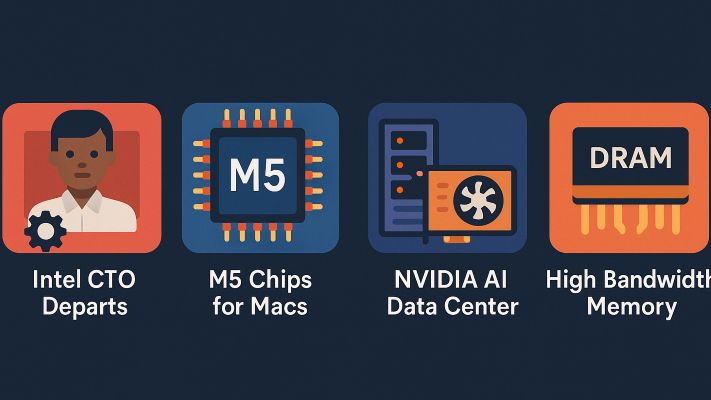AI Navigation
- articleAI Trends
- lightbulb_2AI Tips
- assistant_navigationAI Navigation
- heatHot Articles
- emergency_heat_2Hot Tips
- format_list_numberedPrompt Formatter
- psychologyTest Center(RPI)
November 11, 2025 · 24-Hour AI Briefing: Intel’s CTO Joins OpenAI, Apple’s M5 Push, NVIDIA Powers Germany’s AI Center, and SK Hynix Redefines Memory
Summary:
From chip leadership shake-ups to next-generation compute infrastructure, today’s AI landscape reflects both disruption and acceleration. Intel loses a key technologist to OpenAI, Apple doubles down on its M-series evolution, NVIDIA brings AI horsepower to Europe, and SK Hynix pioneers a storage breakthrough that could reshape “AI on Device.”

Intel CTO Joins OpenAI — A Strategic Shock to Intel’s AI Roadmap
Intel’s Chief Technology Officer Sachin Katti has officially left the company to join OpenAI. CEO Pat Gelsinger will temporarily assume the CTO role while Intel reorganizes its leadership around AI.
Commentary:
Katti was instrumental in elevating Intel’s AI division from a sub-business within the data-center group to a core corporate strategy. His abrupt departure creates a temporary gap in Intel’s AI roadmap and coordination.
In the AI era, vision alone isn’t enough — companies must build environments that attract and retain top technical minds. OpenAI’s magnetic pull on elite engineers shows that pure innovation culture may now outweigh legacy corporate structure.
Apple Expands M5 Chip Across Its Entire Mac Lineup
Apple plans to roll out its M5 chip across all Mac products, with M5-powered Mac Studio and Mac mini models expected in mid-2026. The move marks a full transition to the fifth generation of Apple Silicon.
Commentary:
Built on TSMC’s 2 nm process, the M5 will offer major leaps in energy efficiency and integrated AI acceleration.
It’s designed to strengthen Apple’s edge among creative professionals and enterprise users — and to power Apple Intelligence, the company’s on-device AI framework.
By merging hardware and AI at the OS level, Apple is pushing macOS further into the era of local intelligence.
NVIDIA and Deutsche Telekom Invest €1 Billion in AI Data Center for Germany
NVIDIA and Deutsche Telekom have announced a €1 billion AI data-center investment in Germany, scheduled to go live in early 2026. Once operational, it is expected to boost Germany’s AI compute capacity by about 50% — making it one of the country’s largest GPU deployments.
Commentary:
Europe has long lagged behind the U.S. and China in large-scale AI infrastructure. This initiative not only strengthens Germany’s digital sovereignty but also lays groundwork for local LLM training and enterprise AI adoption.
Still, compared to America’s and China’s multi-billion-dollar clusters, €1 billion is modest — but it’s a crucial first step.
In the age of AI, compute is the new oil, and Germany may have just struck its first well.
SK Hynix Develops HBS (High Bandwidth Storage) to Power the AI-on-Device Era
SK Hynix is developing a breakthrough memory architecture called HBS (High Bandwidth Storage), capable of stacking up to 16 DRAM and NAND modules connected through vertical fan-out (VFO) lines. The design dramatically improves data throughput and processing efficiency.
Commentary:
Today’s smartphones and tablets often hit “memory walls” when running local AI models. HBS overcomes these bottlenecks through 3D heterogeneous integration of DRAM and NAND, enabling high-density, low-latency data pathways.
If realized, HBS could become the next revolution after HBM — fueling faster, smoother AI inference on consumer devices.
The technology positions SK Hynix as a key player in the AI supply chain, competing with Samsung’s HBM-PIM and Micron’s LPDDR5X + UFS combo solutions.
For more AI insights, business intelligence, and tech trends, visit:
https://iaiseek.com/en
Want to catch up on what happened in the AI world over the last 72 hours? Read:
November 10, 2025 · 24-Hour AI Briefing: Meta’s Ad Scandal, Amazon’s Low-Cost Offensive, and Tesla’s V2L Breakthrough